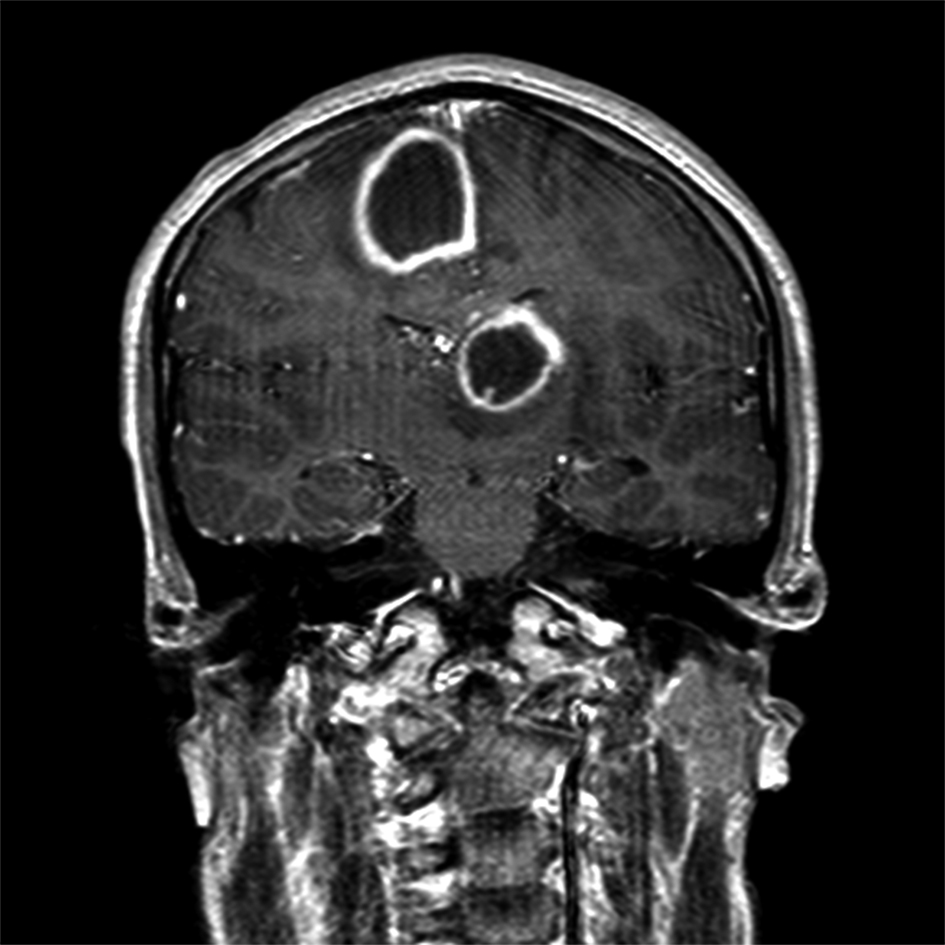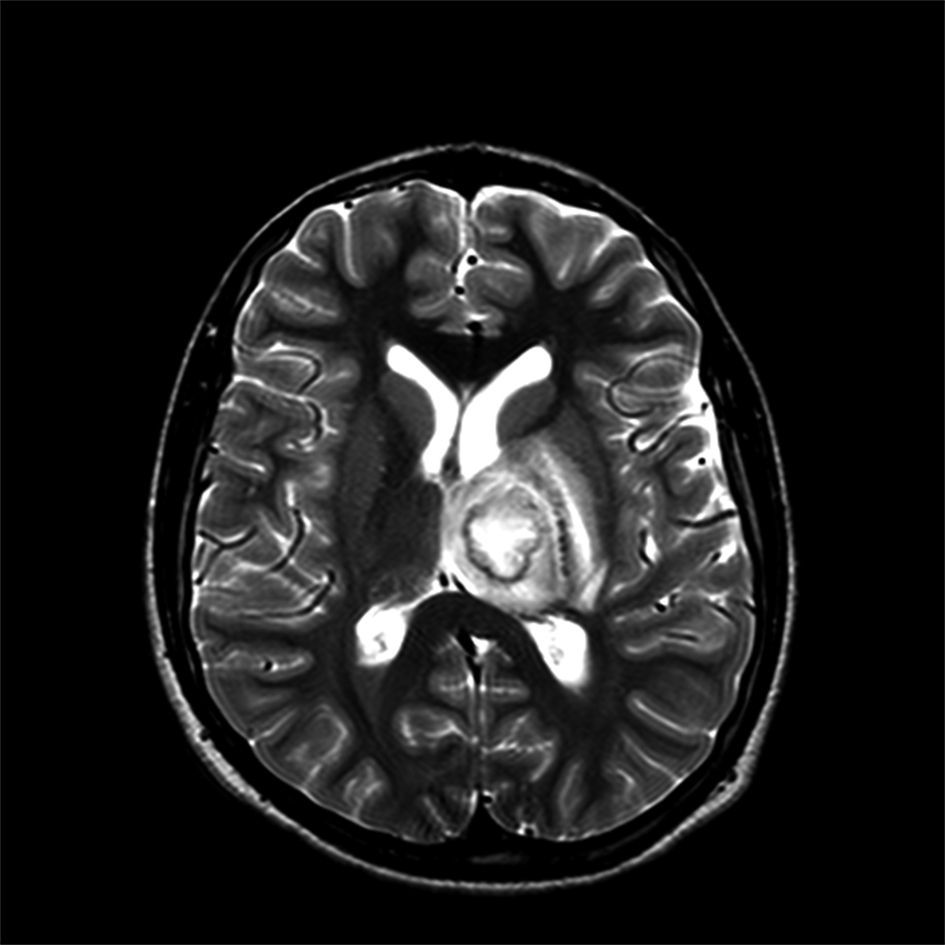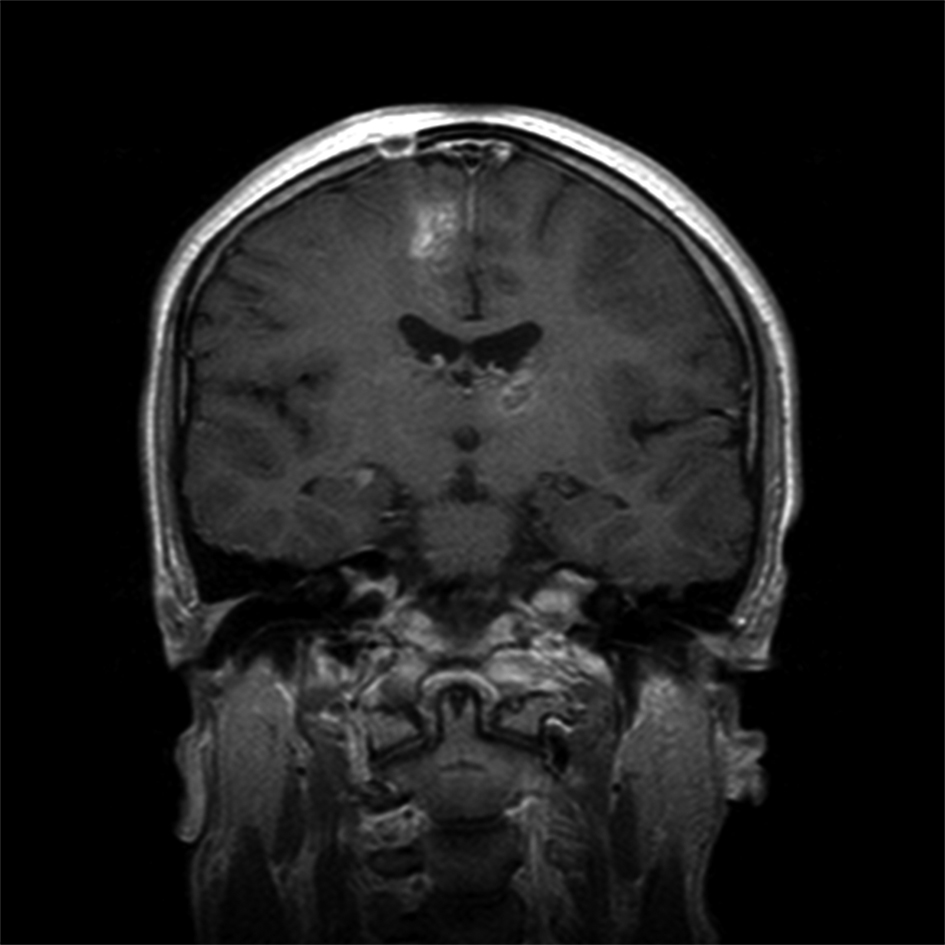
Figure 1. T1-weighted contrast-enhanced coronal image from the day of admission shows abscesses with typical thick-walled enhancement in left ventral thalamus and right superior frontal gyrus, just above the cingulate gyrus.
| Journal of Neurology Research, ISSN 1923-2845 print, 1923-2853 online, Open Access |
| Article copyright, the authors; Journal compilation copyright, J Neurol Res and Elmer Press Inc |
| Journal website http://www.neurores.org |
Case Report
Volume 2, Number 3, June 2012, pages 109-114
Neuropsychological Impact of Bilateral Cerebral Abscesses in an Adolescent
Figures



Tables
| Measure | Standard Score |
|---|---|
| Note. DKEFS: Delis-Kaplan Executive Function System. | |
| Wechsler Intelligence Scale for Children IV | |
| Full-Scale IQ | 79 |
| Verbal Comprehension Index | 98 |
| Perceptual Reasoning Index | 71 |
| Working Memory Index | 91 |
| Processing Speed Index | 73 |
| Woodcock-Johnson III Tests of Achievement | |
| Calculation | 102 |
| Math Fluency | 94 |
| Math Calculation Skills | 100 |
| Letter-Word Identification | 103 |
| Reading Fluency | 87 |
| Spelling | 119 |
| Handwriting | 125 |
| Academic Skills | 110 |
| Symbol-Digit Modalities Test | 98 |
| Expressive Vocabulary Test, Second Edition | 95 |
| California Verbal Learning Test, Children’s Version | |
| List A Total Trials 1 - 5 | 85 |
| List A Trial 1 Free Recall | 85 |
| List A Trial 5 Free Recall | 85 |
| List B Free Recall | 78 |
| List A Short-Delay Free Recall | 85 |
| List A Short-Delay Cued Recall | 85 |
| List A Long-Delay Free Recall | 78 |
| List A Long-Delay Cued Recall | 85 |
| Correct Recognition Hits | 85 |
| Discriminability | 93 |
| Perseverations | 85 |
| Intrusions | 93 |
| Children’s Memory Scale | |
| Stories - Immediate | 75 |
| Stories - Delayed | 75 |
| Stories - Delayed Recognition | 90 |
| NEPSY-II Memory for Designs | |
| Immediate | 85 |
| Delayed | 80 |
| Rey-Osterrieth Complex Figure Test | |
| Copy | 50 |
| Delay | 71 |
| Hooper Visual Organization Test | 95 |
| Purdue Pegboard | |
| Right Hand | 55 |
| Left Hand | 67 |
| Both Hands | 85 |
| DKEFS Trail Making | |
| Visual Scanning | 90 |
| Number Sequencing | 85 |
| Letter Sequencing | 75 |
| Number-Letter Sequencing | 55 |
| Motor Speed | 80 |
| DKEFS Verbal Fluency | |
| Letter Fluency | 85 |
| Category Fluency | 70 |
| Category Switching Correct | 80 |
| Category Switching Accuracy | 90 |
| Conners’ Continuous Performance Test II | |
| # Omissions | 98 |
| # Commissions | 110 |
| Hit Rate | 95 |
| Hit Rate Standard Error | 98 |
| Variability | 91 |
| Detectability | 112 |
| Response Style | 94 |
| Perseverations | 94 |
| Hit Rate Block Change | 98 |
| Hit Rate Standard Error Block Change | 91 |
| Hit Rate ISI Change | 103 |
| Hit Rate Standard Error ISI Change | 107 |
| BRIEF Subscale | Parent T-Score | Teacher T-Score |
|---|---|---|
| Note. An asterisk (*) indicates a clinically significant score. | ||
| Inhibit | 60 | 48 |
| Shift | 61 | 50 |
| Emotional Control | 60 | 45 |
| Behavioral Regulation Index | 62 | 47 |
| Initiate | 59 | 88* |
| Working Memory | 66* | 70* |
| Plan/Organize | 59 | 78* |
| Organization of Materials | 43 | 51 |
| Monitor | 57 | 73* |
| Metacognition Index | 58 | 77* |
| Global Executive Composite | 60 | 67* |
| BASC-2 Subscale | Parent T-Score | Teacher T-Score | Self T-Score |
|---|---|---|---|
| Note. A single asterisk (*) indicates an at-risk score. Two asterisks (**) indicate a clinically significant score. | |||
| Clinical Scales | |||
| Hyperactivity | 54 | 41 | 33 |
| Aggression | 40 | 43 | — |
| Conduct Problems | 44 | 42 | — |
| Anxiety | 50 | 64* | 35 |
| Depression | 49 | 60* | 40 |
| Somatization | 55 | 44 | — |
| Atypicality | 76** | 54 | 42 |
| Clinical Scales | |||
| Withdrawal | 52 | 86** | — |
| Attention Problems | 53 | 54 | 36 |
| Learning Problems | — | 67* | — |
| Attitude to School | — | — | 35 |
| Attitude to Teachers | — | — | 39 |
| Locus of Control | — | — | 37 |
| Social Stress | — | — | 34 |
| Sense of Inadequacy | — | — | 44 |
| Adaptive Scales | |||
| Relations with Parents | — | — | 62 |
| Interpersonal Relations | — | — | 59 |
| Self-Esteem | — | — | 57 |
| Self-Reliance | — | — | 33* |
| Adaptability | 49 | 42 | — |
| Social Skills | 33* | 30** | — |
| Leadership | 40* | 33* | — |
| Activities of Daily Living | 40* | — | — |
| Study Skills | — | 40 | — |
| Functional Communication | 39* | 35* | — |
| Composite Indices | |||
| School Problems | — | 61* | 30 |
| Externalizing Problems | 46 | 41 | — |
| Internalizing Problems | 52 | 57 | 35 |
| Inattention/Hyperactivity | — | — | 32 |
| Behavioral Symptoms Index | 55 | 58 | — |
| Emotional Symptoms Index | — | — | 42 |
| Adaptive Skills | 38* | 34* | — |
| Personal Adjustment | — | — | 54 |